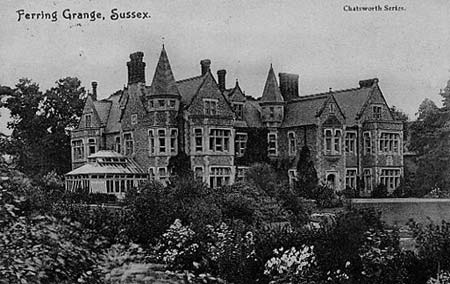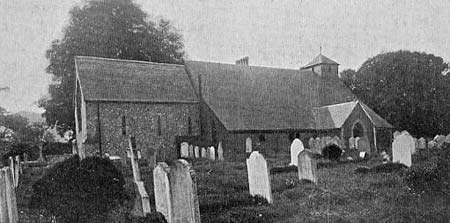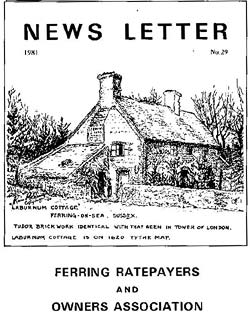|
This article was first published in the West Sussex Gazette on 22nd June 2000
It is difficult to imagine that the sprawling village of Ferring had humble beginnings in a forest clearing, or that its inhabitants could have been struck down with the Plague. But according to an historical entry in an old newsletter this seems to have been the case. The article, written by one Harry Tyrell, who was vice-chairman of The Ferring Ratepayers and Owners Association, appears in their 1981 newsletter, and charts Ferring's Progress through the ages.
The following is a transcript of Harry Tyrell's composition:-
For many centuries now there has been human habitation in the Ferring area, though long before Ferring itself was established. Evidence of this has been found at nearby Highdown Hill: from the Bronze Age (c.1500 B.C.); through the Iron Age (c.500 B.C.); and Romano-British occupation in the 3rd Century A.D. Later, part of this hill was used as a Saxon burial ground.

Ferring Grange, originally a Manor house before being turned into a popular hotel in the 1920s, was gutted by fire in 1946 and subsequently parts of the building not destroyed were converted into flats. The old house was set in extensive grounds which were sold off for housing development to become the present day Ferring Grange Gardens, Grange Close and Grange Park.
|
Ferring as a village begins with the Saxon invaders about 450 A.D., who established themselves and their followers in settlements along the coast, which became known as Ferring, Tarring, etc. along with the other 'ings' of what is now Sussex. By the time of the Norman Conquest the village was large enough to be mentioned in the Doomsday Book, having perhaps 20 or so households.
In early times much of this part of the country was covered with dense forest or heavy tangled woodland with clearings for pasture and agriculture around the villages. Place names ending in 'hurst', such as Billingshurst, Warminghurst - or 'den' - such as Tenterden, (which occurs in scores of places in Kent), indicate the locations of many of the cultivated areas won by hard toil out of the original forest.
These forests provided food for swine, herds of which ate their way from place to place, being driven by the swine-herds along driveways, still traceable today in some country roads by their very high hedge banks. One of these driveways ran from Horsham via Thakeham and Sullington then over the Downs and ended at Ferring. Here the swine would have found plenty to eat with acorns and other forest provenders, and then quietly munched their way back fattened up for the Horsham market.
For Ferring the centuries rolled by without much relief from the grinding daily toil of a small rural community, and with disease and death never far away from their inhabitants. The tide of history little touched their lives. Even when the Civil War came along their involvement seems to have been merely that the vicar was displaced (1655-58) by 'three preachers of the gospel' described later as 'Cromwellian intruders'. A vicar was returned to the parish after the Restoration.
Some kind of epidemic seems to have afflicted the village during the years 1678-80, when, of 40 entries in the Parish Registers, there were 38 burials, no marriages and only four christenings. This could have been due to a visitation of the plague, which occurred from time to time throughout the centuries, the last most serious outbreak being the Plague of London in 1666.

Ferring Church, as featured in this 60-year-old picture postcard, has always been (along with Ferring Grange) the nucleus of the village
|
Later, in 1718-22, no marriages are recorded and during 1744-47 only three burials. However, the population must have varied little over the years and even up to the latter end of he 19th Century the village still consisted of the houses in the immediate neighbourhood of the Church and the Grange, with altogether about 300 inhabitants.
Up to the time of the beginning of the 1939-45 war the population here was only about 800. It remained static during the war as this part of the South Coast was a prohibited area, but after that a relatively rapid increase took place giving a figure of 2000 in 1949. Then steady growth took place each decade until just over 3000 people were living in Ferring in 1972.
Thus the once-upon-a-time clearing in a forest has become the village we know today. But with all the continued building we see going on still, and the disappearance of one green field after another as the urban envelopment creeps ever westwards, who knows what the end of the Century will bring to Ferring?
The end of the century about which Harry Tyrell pondered in the newsletter is now upon us, and today, thanks to pressure exerted by those who seek to preserve Ferring as a village, it is still surrounded by green fields.
Lent to me by Mrs Kathleen Skeet, who has a keen interest in the old village, the newsletter featured an old house on the front cover, the sight of which sparked off some interesting memories.

Laburnum Cottage, Sea Lane, Ferring as it appeared on the front cover of a 1981 newsletter of the Ferring Ratepayers and Owners Association. This was the house where Granny Jenkins sold vegetables from her front room before the war.
|
She recalled that the old house, called Laburnum Cottage, which she recognised as being in Sea Lane, Ferring, was owned by a lovely old lady known in the village as Granny Jenkins.
'My mother,' Kathleen told me, 'often sent me down to her to buy vegetables, which she sold from her front room. She was our local information service and knew all the local gossip.'
In those days everybody knew everyone else. The Langridge family owned the cottages next to it.
'We were known as the Cuthbert family and lived in Homestead Cottages, Sea Lane, opposite Ilex Way in Sea Lane.'
'We had many famous people living in the village including Arthur Askey, and the Palumbos, who were friends of the Duke of Windsor (the Queen's uncle); also a lovely man, whose name escapes me, who was a joy to listen to with his Palm Court Orchestra on the radio.'
'At the entrance to Ilex Way or Avenue, were very regal tall iron gates and railings, similar to the ones outside Buckingham Palace. These were taken away during the war to make munitions.'
Many thanks to Kathleen for her memories and the loan of the newsletter, which together make a valuable contribution to local history and will take their rightful place in the archive for posterity.
| |


